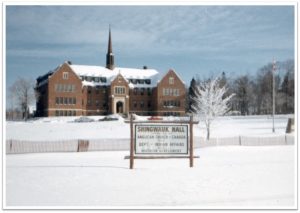11 Shingwauk Hall (1935-1970)

In 1935, the new Shingwauk Hall opened on the grounds just north of the old building, which would soon be razed. The new building was equipped with electricity and running water and was designed to accommodate 140 students, with boys and girls located in separate wings. The building contained classrooms, offices, workshops, a laundry room, kitchen, playroom, and eating area. Its two top floors were dormitories and staff bedrooms.
Although the Shingwauk Indian Residential School would become known as the Anglican Church’s flagship Residential School, the Residential School Era is characterized by its church-run, federal government-funded austerity – doing the bare minimum for as little money as possible.
Over this period of ‘modernization’, almost all of the trades-based training and apprenticeship programs were phased out. Students in the Residential School Era received a basic education in religion, English, history, geography, and arithmetic, supplemented with farming and housework. According to war-time principal the Rev. Arthur E. Minchin, those who passed their Grade 8 examinations “at a reasonably early age” were afforded the opportunity to attend a technical or collegiate institute. The very low number of students who pursued this option suggests the ineffectiveness or inadequacy of the education provided at Shingwauk, which was reflective of the experiences of Residential School students across the country.
The Integration Era
Beginning in the mid-1950s, Shingwauk Indian Residential School transitioned into a boarding house for Indigenous students attending integrated schools in and around Sault Ste. Marie. Many attended Anna McCrea Public School and Sir James Dunn Collegiate and Vocational School, located on the northernmost portion of the original site. The two schools were built after part of the property was transferred to what was then the Sault Ste. Marie Board of Education for the express purpose of integrating Indigenous students into white society. Some older students were also housed in non-Indigenous homes in the city of Sault Ste. Marie.
Cultural Erosion and Reclamation
The overwhelming influence of non-Indigenous ways of life, and particularly an Anglican worldview, permeated this site for almost 100 years. Even as Shingwauk students were beginning to integrate with non-Indigenous students for the purposes of education, this continued. In these photos, we observe children and youth celebrating Halloween, preparing food at a cookout, and holding their diplomas – all activities that show us that Indigenous traditions continued to be replaced by those of mainstream Canadian culture. The work of cultural reclamation, which began almost immediately after Shingwauk Hall closed in 1970, and of which this exhibition is a part, is a testament to the resilience and strength of Survivors.

